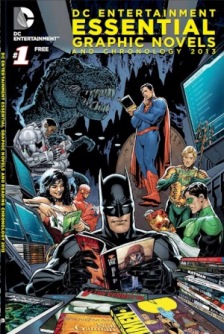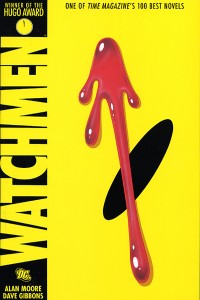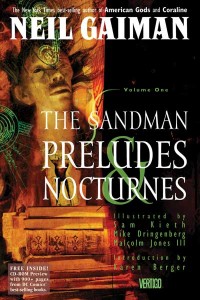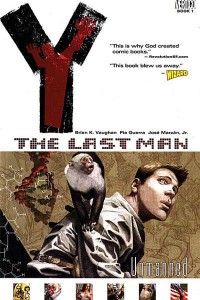This May DC released a free guide in magazine-like format, about the size of a small prestige graphic novel itself, containing a list of “essential graphic novels” and also a “chronology” for new readers. It’s not a bad idea considering what a difficult time new readers, or those who have left for awhile, can have finding jumping on points.
WATCHMEN
BATMAN: The Dark Knight Returns
THE SANDMAN: Volume 1, Preludes and Nocturnes
BATMAN: Year One
V FOR VENDETTA
SAGA OF THE SWAMP THING: Book One
FABLES: Volume 1, Legends in Exile
BATMAN: The Killing Joke (the Deluxe Edition)
Y: THE LAST MAN, Volume 1, Unmanned
ALL STAR SUPERMAN
KINGDOM COME
BATMAN: The Long Halloween
THE LEAGUE OF EXTRAORDINARY GENTLEMEN: Volume 1
BATMAN: Earth One
GREEN LANTERN: Rebirth
AMERICAN VAMPIRE: Volume 1
BLACKEST NIGHT
FINAL CRISIS
JLA: Volume 1
IDENTITY CRISIS
BATMAN: Hush
JOKER
THE FLASH: Rebirth
SUPERMAN: Earth One, Volume 1
PLANETARY: Volume 1, All over the World and Other Stories
If you managed to pick up the free guide already, you’re probably skipping over that list, but on the off chance you haven’t seen it yet, it’s worth scanning through. Obviously, the list isn’t in alphabetical, chronological, or character-based order, so it must form some kind of chosen ranking system, though putting too much emphasis on the order might be a mistake. 
But the number of BATMAN titles is a little surprising. He’s been one of the most appealing characters in DC history, particularly once films started being made, and is more or less the de facto symbol of DC more than Superman these days, but are that many Batman titles really so essential? Many of them are by prominent writers and artists and have justly gained critical praise, which does seem to justify plenty of Batman in the list. But when you consider how many graphic novels have been released by DC, it seems like there might have been a little more room for diversity.
Vertigo gets its own separate list of “top” series, versus individual graphic novels later on in the catalogue, too, and they are:
THE SANDMAN
FABLES
Y: THE LAST MAN
To be fair, other titles are listed as Vertigo graphic novels that readers might be interested in, but these three series receive their own break-down into volumes and are also rounded off by a spotlight and listing of the works of Alan Moore and Grant Morrison for Vertigo. 
There’s room to argue that more Vertigo titles should have made it into the Top 25 overall due to the critical attention and wide readership they enjoy even over long periods of time, stocking the shelves of libraries and being added to high-school and college level reading lists, whereas collections of big DC crossover events rarely reach that cultural status. It would be unfair to knock superhero titles out of the Top 25 simply because they are superhero graphic novels, but should be judged on their own merit. There’s little doubt that ALL STAR SUPERMAN is a classic in its own right and deserves to be given attention, but it really comes down to how we judge the word “essential”.

Hannah Means-Shannon writes and blogs about comics for TRIP CITY and Sequart.org and is currently working on books about Neil Gaiman and Alan Moore for Sequart. She is @hannahmenzies on Twitter and hannahmenziesblog on WordPress.







One book that I just can’t understand why DC doesn’t keep in pint is Tim Truman’s Hawkworld. I know it’s as good as an Elseworlds know (or whatever), because of the idiotic handling of everything Hawk-related that came after (until Johns started trying to fix the continuity, maybe — I never read any of that), but DAMN Hawkworld was great.
It was definitely better than Final Crisis…
All Start Superman? Why, has he stopped?
“particularly since it gives short summaries of individual volumes,”
Mm? “Contains issues #xx – yy” is a “summary”?
-B
Granted, math’s not my strong suit, but is that list 1/5 (20%) Alan Moore…? Did Alan Moore write more “essential” books for DC, according to this list, than Geoff Johns and Grant Morrison…?
Wow, that’s a lot of Alan Moore. It’s amazing how they keep going back to the well with his work when they have access to guys like Gaiman and Vaughn…big names they haven’t managed to totally piss off (yet). (Obviously it’s due to the money they make off of it. I bet they would love to make more money off of him, but you can’t just throw money at guys like Moore to patch up all the grievances…no wonder people hate him so much. No one likes people who aren’t motivated by money.)
Yeah, the fact that their 25 essential GNs is so reliant on a few good years in the 80s-early 90s says a lot about both DC’s obsession with the past and their inability to gain traction in the present.
Are they under the impression that the “Earth One” comics turned out all right?
“Essential to buy? Essential to read? Essential to understanding the DC Universe?”
From the composition of the list, it looks like it was formed by a committee where everyone had their own idea of what “Essential” meant.
Mostly it kind of looks like they might have taken their sales figures for Graphic Novels over the past few years, grabbed the top 50, cut it down to 25 by removing a few Batman collections and only having “volume 1” of any series, and said “there you go – our top 25 best-selling graphic novels.” That can’t be all of it because neither Preacher nor V for Vendetta are on that list and I’d expect to see it there if that was the formula they used (maybe they had an upper bound on non-DC superhero titles that cut those) but I suspect it’s close to the reasoning used.
Whoops – V for Vendetta IS on the list. Scratch that then – I think Preacher may be the only one missing that I’d expect to see if it was purely a “sales bulk” list.
Yea, the problem with such a list is that word “essential” is basically meaningless without the writer(s) defining what they mean by it. Usually such list go by two routes, either – best (i.e my favorites) or most influential (i.e importance).
If it’s a “best” list, well… I can’t argue with it (that is – I can say it’s wrong but since it is meant to subjective there is no point). If they mean to say “influential” than this list is objectively bad (too many new things, too many works that aren’t around long to shape the genre).
Looking at it I think that this is simply a list of their highest selling graphic novels (over a long period of time), there is not a single GN on the list that I would not expect to see in a list made by general public vote – there is not a shred of “personality” in it, it could have been by a computer doing statistics through Goodreads records: it’s dull.
Seriously? Final Crisis is in the top 25 but Crisis on Infinite Earths isn’t?
This “essential” list is very telling. It’s a suicide note. It’s Oldsmobile’s business plan. Livin’ in the past baby, it ain’t really livin.’
I’m in agreement with Jer – where’s Preacher? And for that matter, where is 100 Bullets? I think that there were too many novels devoted to Batman, however, I was happy to see more recent work on the list, such as Saga.
A DC essential graphic novel list that doesn’t include Preacher or 100 Bullets can’t be taken seriously.
And they have FINAL CRISIS but no CRISIS ON IFINITE EARTHS???? Come on….somebody needs to rethink this a wee bit.
It’s a crime that Justice is not on this list.
This “essential” list is very telling. It’s a suicide note. It’s Oldsmobile’s business plan. Livin’ in the past baby, it ain’t really livin.’
lol what would you prefer it be, a list of New 52 stuff? You know, those comics produced by creators that made all those stories you love and remember from the 90s? You could tell even Grant Morrison’s heart wasn’t in it the very issue he had to put Superman in that dumb grimdark moviecool armor.
This list, and book, doesn’t so much feel like a “must read” list so much as a “Hi! This is what we’re going to be keeping in print and everything else we would like to fall into obscurity and be forgotten about please!” list. :(
No Starman? That’s blasphemous. As is not including DC New Frontier.
I think Batman: Court of Owls is better than a lot of this list. Detective Comics: Batwoman. Preacher. Transmetropolitan. Promethea. Golden Age. Wildcats 3.0. Top Ten. Astro City. Authority. Stormwatch. Sleeper. Gotham Central.
I agree with a lot of sentiments already expressed in these comments…
Shocked that there’s no Crisis on Infinite Earths and Preacher and no Teen Titans and Wonder Woman of any kind??!!?
Would get rid of the Earth One graphic novels and couple of the Crisis books.
Include Astro City: Life in the Big City by Busiek, Anderson & Ross, possibly Superman: The Man of Steel, Vol. 1 by Byrne; Wonder Woman, Vol. 1: Gods & Mortals by George Perez; Teen Titans: The Judas Contract by Wolfman & Perez; Teen Titans, Vol. 1: A Kid’s Game by Johns & McKone for superhero stuff. And Camelot 3000 by Barr & Bolland, Global Frequency by Ellis & various; and 100 Bullets by Azzarello & Risso for genre variety. And Tiny Titans, Vol. 1: Welcome to the Treehouse by Baltazar & Franco and a Batman Adventures books for the kids.
If I were giving a new fan 25 books and I didn’t want them to hate me
ALL STAR SUPERMAN
AMERICAN VAMPIRE: Volume 1
ASTRO CITY: Volume 1, Life in the Big City
BATMAN: Year One
CRISIS ON INFINITE EARTHS
DC NEW FRONTIER
FABLES: Omnibus 1
GOTHAM CENTRAL: Volume 1, In the Line of Duty
JLA: Volume 1
KINGDOM COME
THE LEAGUE OF EXTRAORDINARY GENTLEMEN: Volume 1
LEGION OF SUPERHEROES: GREAT DARKNESS SAGA
PLANETARY: Volume 1, All over the World and Other Stories
PREACHER: Volume 1, Gone to Texas
PROMETHEA: Book 1
SEVEN SOLDIERS OF VICTORY: Book 1
SLEEPER
STARMAN: Omnibus 1
TEEN TITANS: JUDAS CONTRACT
TOP TEN
TRANSMETROPOLITAN: Volume 1, Back on the Street
V FOR VENDETTA
WATCHMEN
WILDC.A.T.S. VERSION 3.0 Year One
Y: THE LAST MAN: Omnibus 1
Nice one Jesse!
I have to say as a retailer, these look like DC’s best selling trades and collections. Nothing particularly radical about it.
Johnny, Moore was right they have no new ideas and still live off of him. This is an admission, it’s the past they have no new ideas.
Why is everybody so upset about listing so many older titles? Shouldn’t some of these “essential” titles withstand the test of time? I loved the court of owls, but damn, give it time. Can any of the people complaining tell me of a newer GN from DC that I should be reading. I’m not trying to be mean, I just want to understand what these people, that are saying DC is living in the past, think is a worthy comic.
It looks a little like an attempt to reach out to the book store market by way of the trades market but it misses the mark a bit. Making trades more user friendly for non monthly readers would be a fab way of reaching out to a larger and more diverse audience but only Vertigo (and Image, IDW, Dark Horse et al) has really managed that with its helpful numbering of volumes.
The number of Batmen is unsurprising, he is by far DC’s biggest and most accessible seller in nearly all markets. What I find interesting is that in the book store market he is DC’s only evergreen seller that isn’t either Vertigo or a one-off more literary GN (V, TLoEG etc).
I did a bit of number-crunching on these figures, just to see what that might tell us.
First of all, there’s the Alan Moore factor – five of the titles (BATMAN: The Killing Joke, WATCHMEN, V FOR VENDETTA, SAGA OF THE SWAMP THING, and THE LEAGUE OF EXTRAORDINARY GENTLEMEN) are written by Moore, and special pleading could be made for two of the other titles (KINGDOM COME and BLACKEST NIGHT) being based on ideas of his as well. Which gives us between 20% and 28% of this list being the work or inspiration of one man.
And if we look at the number of titles written by British writers, we find that there are 10 of them, or 40%. For an american-based company, that’s a lot.
There is, as has been mentioned, the Batman factor, with with seven titles featuring or related to the character (BATMAN: The Dark Knight Returns, BATMAN: Year One, BATMAN: The Killing Joke, BATMAN: The Long Halloween, BATMAN: Earth One, BATMAN: Hush, and JOKER), which rises quite considerably if you also count the four team or ensemble books that he’s also in (FINAL CRISIS, IDENTITY CRISIS, JLA: Volume 1, and KINGDOM COME), leaving him with between 28% and 44% of the titles.
And there’s the age factor – 7 of these titles are more that 20 years old; 11 of them are more that 15 years old; and 15 of them are more than 10 years old.
Three of the titles originated elsewhere: V FOR VENDETTA, THE LEAGUE OF EXTRAORDINARY GENTLEMEN, and PLANETARY, and only make it on the list through being published by DC’s acquisitions.
And, finally, if we leave out titles featuring characters that are in some cases three-quarters of a century old, like Superman, Batman, Wonder Woman, The Flash, and Green Lantern, who have hideously complicated and constantly revised back-stories, and just concentrate on stories that are of more recent origin, we get down to a list that comprises these 9 titles:
V FOR VENDETTA – Alan Moore, 1982/1989
SAGA OF THE SWAMP THING: Book One – Alan Moore, 1984
WATCHMEN – Alan Moore, 1986
THE SANDMAN – Neil Gaiman, 1989
PLANETARY: Volume 1 – Warren Ellis, 1998
THE LEAGUE OF EXTRAORDINARY GENTLEMEN – Alan Moore, 1999
FABLES: Volume 1 – Bill Willingham, 2002
Y: THE LAST MAN, Volume 1 – Brian K Vaughan, 2002
AMERICAN VAMPIRE – Scott Snyder, 2010
Where, once again, we see 4 titles by Moore, and 2 more by other Englishmen. And, most tellingly, only one title from the last decade.
So, what does this list tell us? Is it a frivolous marketing exercise, or the last frightened howl of a dinosaur, pleading for its life? More the latter, it seems to me.
@wahab I think you are missing the point. It’s not that people want newer stories like Court of Owls listed. It’s that nothing of any real merit has been done since these books. DC has no new ideas and has produced nothing like these classics. That’s not a good sign and if you think Court of Owls rates with any of these books that’s not a good sign either.
Is the list of where readers that fell off the bandwagon several years ago can learn where to jump back on again downloadable?
The irony here is that of Marvel and DC, DC has been far more adventurous in reaching out beyond its core characters. In the past, they’ve published Stuck Rubber Baby, Understanding Comics, Will Eisner’s canon, Kyle Baker’s books, The Alcoholic, plenty of Harvey Pekar, The System, Gregory, Tug and Buster, Epicurus the Sage, Can’t Get No, Mardi, Revolver. All that, in addition to whatever else you want to throw in from Vertigo, Paradox, Zuda et. al. It’s an impressive list once you get past an avalanche of spandex. Marvel has Shanower’s Oz books, a couple of recent literary adaptations and the rest is Spiderman and Daredevil all the way down the line.
“Yeah, the fact that their 25 essential GNs is so reliant on a few good years in the 80s-early 90s says a lot about both DC’s obsession with the past and their inability to gain traction in the present.”
Or the fact that you need time to decide what books stand the test of time?
I think more-so than the age is the amount of books by alienated DC talent. Just off the top of my head: Moore hates DC, Waid hates Didio, Frank Miller’s latest project was declined by DC, etc.
Collections that sell well or that are the best, using literary and artistic standards, aren’t necessarily the best ones for introducing people to the DC universe–which is, I suppose, one of the objectives of an essentials list, or should be. WATCHMEN might be as good a read as anything else DC has produced, but it’s not a good intro to anything.
I wonder what DC Editorial provides to new writers who need to learn about the basics of a hero? Do they provide a copy of the DC Comics Encyclopedia? Some key collections? Refer him to Wikipedia(?!) I see that the encyclopedia listed “key” storylines for at least some characters.
I’d find it interesting to see a collection of profiles of the heroes, intended as a writer’s guide of sorts, which described a hero’s key attributes and aspects, and noted some aspects of the character that were undeveloped or unexplored. Composing a profile would force the researcher to ignore such things as revised origins and to describe the essence of the character, something any writer could use as the basis for a storyline in which he developed the hero.
SRS
@ SRS – I doubt they give new writers such resources.
“SCALPED” or GTFO.
Comments are closed.